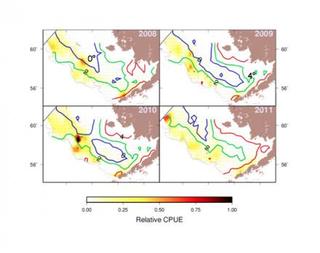Pollock Quota Could Go Down According to NMFS Assessment

Tuesday, November 08 2011
The amount of pollock that fishermen are able to catch will likely shrink next year.
The National Marine Fisheries Service has posted its draft assessment of the Eastern Bering Sea pollock stock, and it proposes revising the allowable biological catch -- the amount that fishermen can safely harvest in a year without negatively impacting the fishery -- down to 1.08 million metric tons. That’s a 14 percent decline over this year’s ABC of 1.270 million metric tons.
That figure is also a big drop from last year’s projection. Last November, NMFS had expected the pollock biomass to grow in 2012, and scientists put their anticipated ABC for 2012 at 1.6 million metric tons.
The stock assessment cites a variety of factors for managing the pollock fishery more conservatively next year. Two recent NMFS surveys showed that the biomass, or total weight of pollock available in the water, has gone down sine 2010. Data analysis has also shown that NMFS might have initially overestimated the amount of young pollock in the region, and current estimates of the amount of 2- and 3-year-old pollock remain “highly uncertain.” Additionally, the assessment cites slow fishing by the pollock fleet as a reason for potentially bringing down the pollock quota. This year, the fleet left 5 percent of the fish they were allowed to catch in the water.
Scientists will approve a final allowable biological catch next week at the groundfish plan team meeting in Seattle. In December, the North Pacific Fishery Management Council will then use that limit to set the quota for the pollock fishery.



